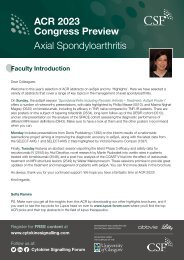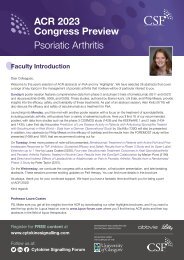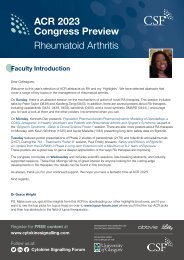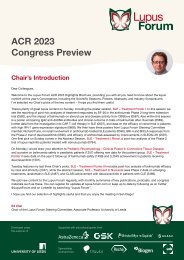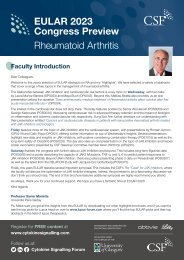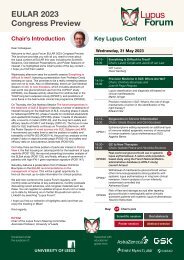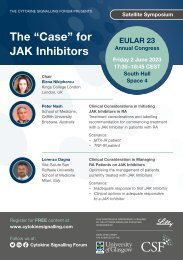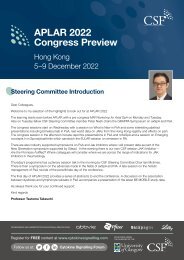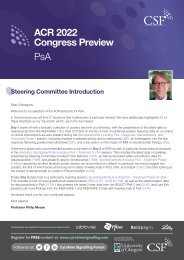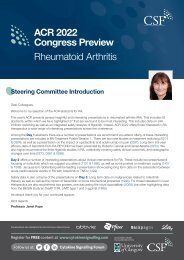EULAR 2018 Review
You also want an ePaper? Increase the reach of your titles
YUMPU automatically turns print PDFs into web optimized ePapers that Google loves.
was no suggestion of an increased risk of serious infection in any absolute lymphocyte<br />
count category [#0330].<br />
The third interim analysis of OPAL Balance, an open-label LTE study of tofacitinib in<br />
patients with PsA, was reported by Nash, et al. Of the 686 patients treated in the study,<br />
468 remained in the study at data cut-off. To 36 months, 2186 AEs were reported in 79.6%<br />
of patients. SAEs, discontinuations due to AEs and serious infections were reported in<br />
13.8%, 8.6% and 1.7% of patients, respectively.<br />
HZ was reported in 2.9% of patients, MACE in 0.7%, malignancies in 3.5% (including 12<br />
pts with NMSC) and uveitis in 0.3%. No AEs of GI perforation or inflammatory bowel<br />
disease were reported. There were 5 deaths, none of which were attributed to treatment as<br />
assessed by the investigator. The authors concluded that over 36 months in the LTE, the<br />
safety profile of tofacitinib in patients with active PsA was generally similar to that of the<br />
Phase 3 studies. Efficacy was maintained across multiple disease domains to Month 30<br />
[#0293].<br />
Effect of tofacitinib on patient-reported outcomes in RA, PsA and AS<br />
Ogdie, et al. showed that tofacitinib treatment (5 mg BID or 10 mg BID) was associated<br />
with a rapid and sustained reduction of pain in patients with RA, PsA and AS. In patients<br />
with RA or PsA who were csDMARD-IR or TNFi-IR, mean Patient's Assessment of Arthritis<br />
Pain (PAAP)-VAS at baseline (5 mg BID, range 55.7–65.7 mm; 10 mg BID, 54.4–60.1 mm)<br />
decreased as early as Week 2 and continued to decrease through Month 6 (30.9–34.4<br />
mm; 28.2–36.7 mm); decreases were numerically greater versus placebo and the<br />
magnitude of change was similar in RA and PsA populations. Improvements in SF-36v2<br />
and EQ-5D were observed in all four RA and PsA csDMARD-IR and TNFi-IR populations;<br />
there were improvements in Bath Ankylosing Spondylitis Disease Activity Index (BASDAI)<br />
in the csDMARD-IR PsA and TNFi-IR PsA populations. In the AS population,<br />
improvements from baseline in SF-36v2 Q7, SF-36v2 bodily pain (BP) domain, EQ-5D<br />
Pain/Discomfort (PD) domain and BASDAI Q2, were observed at Week 12 and were<br />
numerically greater than with placebo [#0221].<br />
No evidence for increased risk of DVT or PE with tofacitinib across disease states<br />
Mease and colleagues reported an analysis of DVT and PE across randomised clinical<br />
studies of tofacitinib in patients with RA, PsO, PsA and ulcerative colitis (UC). Up to Month<br />
3 in the placebo-controlled cohort, DVT and PE occurred in two patients receiving placebo<br />
(n=1 RA, n=1 UC); no tofacitinib-treated patients had DVT or PE events. In the dose<br />
comparison cohort, 2 DVT events occurred in tofacitinib-treated patients with RA (5 mg<br />
BID, n=1; 10 mg BID, n=1) and 1 DVT event in a patient with PsA (10 mg BID, n=1); 2<br />
DVT events occurred with MTX and none with adalimumab. With tofacitinib, 5 PE events<br />
occurred in the dose comparison cohort, all in patients with RA (5 mg BID, n=2; 10 mg<br />
BID, n=3). The authors concluded that there is no evidence for an increased risk of these<br />
events with tofacitinib versus other therapies [#0243].



